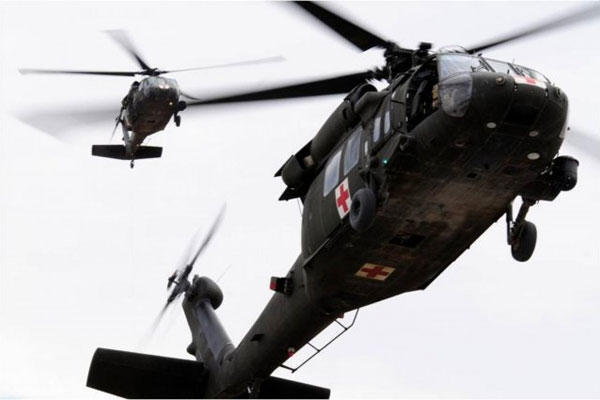KANDAHAR, Afghanistan -- During the course of the last several months, two Medevac companies in Task Force Hammerhead, Company C, 3rd Battalion, 25th Aviation Regiment, and Company C, 1st Battalion, 169th Aviation Regiment, Army National Guard, have participated in a trial program developed by the 25th Combat Aviation Brigade, or CAB, that enables flight medics to administer blood products to wounded Soldiers during the Soldiers' en-route flight care and movement to a medical facility.
The 3-25th General Support Aviation Battalion, 25th CAB, is the first conventional Medevac unit anywhere in the Army to conduct this mission.
"Specifically we implemented a new blood transfusion process for critically-injured patients on Medevac aircraft," said Capt. Nathaniel Bastian, a Forward Support Medevac platoon leader of C, 3-25.
As of December 2012, 80 medical patients have received blood products through the program, which is currently operating at five locations in southern Afghanistan.
More than 60 percent of casualties in Regional Command-South, known as RC-South, are caused by improvised explosive devices, or IEDs, and gunshot wounds. These types of injuries cause patients to lose a large amount of blood. As a result, the patient's chances of survival are increased by an immediate replenishment of blood plasma and red blood cells prior to their arrival at the next level of medical treatment.
"Gaining this blood product transfusion capability aboard Medevac aircraft was a force-multiplier in terms of increasing the probability of patient survivability because it expanded the en-route medical treatment tool kit for our flight medics," said Bastian.
The trial program went through a rigorous and carefully planned training and implementation process while going from its inception phase to a real world mission.
25th CAB Surgeon Maj. Nicole Powell-Dunford, Capt. John Kurtz, a physician assistant, and Capt. Ren Kinoshita, a flight surgeon, both with 3-25, developed the training modules for the blood program and helped co-author the current standard operating procedures.
"Lessons covered basic blood immuno-histology, blood bank handling/storage procedures, medical complications related to blood transfusion, management of complications, and finally a thorough equipment overview with demonstration," said Bastian.
Kurtz trained medics at the first trial site, Forward Operating Base, or FOB, Edinburgh in the Helmand Province.
"After thorough classroom training, the medics were assessed with a written examination and two patient care practical examinations in the back of the Medevac aircraft during day and night scenarios," said Bastian.
Once initial training and validation were completed at Edinburgh, a battle drill and exercise were performed for Robinson to demonstrate the medic's proficiency at using the blood exchange process.
The first 'Vampire' mission was completed June 5, 2012, at FOB Edinburgh.
Vampire is the code name used to identify Medevac missions where blood products were administered to patients.
"Captain Kinoshita and I continued to train the flight medics in RC-South in preparation for setting up the next site at FOB Pasab," said Kurtz.
FOB Pasab was the second location to be validated and approved for Vampire Missions.
Next, the blood program team implemented a method for increasing the speed of care at the Medevac locations that historically have the most severe casualties.
"Though the Medevac standard is for a single medical person in the back of an aircraft with a crew chief, the benefits of a second medical person were observed in RC-Southwest, so we brought the idea to RC-South," said Kurtz
To find the extra medics that would be needed to implement putting two medics in an aircraft, 3-25 turned to a sister unit.
"We then started the process of training select volunteer ground medics from within the brigade," said Kurtz.
The ground medics came from Task Force Lobos, led by the 209th Aviation Support Battalion, 25th CAB, and the two medic team concept was implemented at FOB Pasab.
"The idea was that due to the short transport times that averaged 10 minutes and the complexity of the patients that came out of the area, the addition of a second medically trained person would increase the speed and proficiency of the care to our patients," said Kurtz. "By doing this we increased the level of care given prior to the administration of blood products and ensured we could give this superior resuscitative option to as many patients as possible."
The program continued to expand throughout RC-South and RC-Southwest with Kurtz and Kinoshita training and validating Dustoff elements at FOBs Dwyer, Shukvani, Spin Boldak, Wolverine and Multi-National Base Tarin Kowt.
Kurtz and Kinoshita have trained and validated 25 active duty flight medics, 55 National Guard flight medics, and 10 ground medics in the blood program.
"It has been incredible to be part of the evolution and development of this program because it has truly bolstered our en-route medical capability to help us succeed in completing the Medevac mission," said Bastian.





























